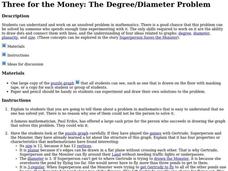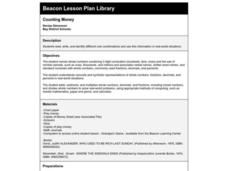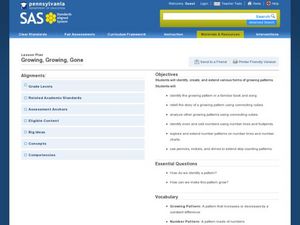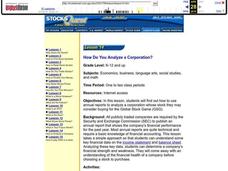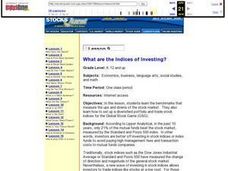Curated OER
Lesson Four - Making Change
Students practice making change. For this money lesson, students complete worksheets in which they find the amount of change they would receive from a dollar bill amount. Students go online and play games on this same concept.
Curated OER
Three for the Money: The Degree/Diameter Problem
Students explore the degree, diameter, planarity, and size of graphs. In this degree, diameter, planarity, and size of graphs lesson, students try to construct a graph with more than 12 vertices that satisfy all other requirements. ...
Curated OER
What a Plan!
Word problems and the strategies to solve them are the focus of this worksheet. Students are given 3 word problems and are prompted to write out their plan for solving each problem. The fourth problem tells students to write out his or...
Curated OER
Counting Money
Students read, write, and identify different coin combinations and use this information in real-world situations.
EngageNY
The Difference Between Theoretical Probabilities and Estimated Probabilities
Flip a coin to determine whether the probability of heads is one-half. Pupils use simulated data to find the experimental probability of flipping a coin. Participants compare the long run relative frequency with the known theoretical...
PHET
Expression Exchange
Bank on your ability to write equivalent expressions. Scholars use an interactive to create expressions using coins. They then convert these to algebraic expressions and figure out how to evaluate them. A game with various difficulty...
Curated OER
Growing, Growing, Gone
Budding mathematicians identify growing patterns in numbers and songs then create their own patterns. They look at number patterns and language patterns and then create their own using money and footprints.
24x7 Digital
TeachMe: 1st Grade
Let your eager learners practice their basic arithmetic and spelling skills with this fun interactive resource! For any primary grade teacher with access to an Apple mobile device, this is a must-have application.
Curated OER
Fun With Fractions
Students play a math game to gain a better understanding of fractions after visiting the American Revolution in the Time Machine. Students attempt to purchase pies from a local farmer. Students use sheets of paper to show knowledge of...
Curated OER
Math -- Money
Students identify a penny, nickel, dime, quarter and a half dollar. They examine the value of each coin and its equivalents (to quarter/dollar). After pairing up with a classmate, each one drills the other one on each coin.
Curated OER
Introducing money (Elementary, Mathematics)
Students study the penny, nickel, dime and quarter, one each day for four days, using a magnifying glass to identify the similarities. Then students discuss differences and value and learn a 'rap' to memorize values.
Curated OER
LCR Math Dice Game
Students play a dice game with play money. In this dice game instructional activity, students use play money and move poker chips back and forth. Students practice their money math using collaborative skills. Students also roll dice to...
Raytheon
Strategies for Solving Math Word Problems
In this strategies for solving math word problems worksheet, students read two pages of examples and explanations, then solve 42 addition, subtraction, multiplication and division problems, answer sheet included.
Curated OER
Reading Bar Graphs #2
Raise the bar in your third grade class with this learning exercise on bar graphs. Youngsters view three graphs representing three different sets of data, and answer questions based on what they analyze. The first set is completed as an...
Roald Dahl
Matilda - Arithmetic
Mr. Wormwood, one of the characters in Roald Dahl's Matilda, is not the most trustworthy of characters. Have student groups take on the roles of car salespeople and play a game to see who can make the most profit by selling refurbished...
Curated OER
Using a Round-O-Meter to Estimate
Explore the concept of rounding numbers to the nearest dollar or dime. Youngsters use a "round-o-meter" to determine which direction to round a number. They make round-o-meters out of a piece of paper, a piece of string, and a paper clip.
Curated OER
Lesson 10 What is an Initial Public Offering (IPO)?
Students understand the difference between primary and secondary stock markets. Through the activities in this lesson, students predict the next best time to invest in IPOs for the Global Stock Game.
Curated OER
Magic Number
Students create addition sentences. They review number lines and how to jump between numbers to solve equations. They play the "Magic Number" game by using a spreadsheet and guessing numbers. They discuss how they found the magic numbers.
Curated OER
Solve Story Problems: Sold! A Mathematics Adventure
Young mathematicians listen to the book Sold!: A Mathematics Adventure by Nathan Zimelman where they encounter ways to solve story problems. They then create and solve start unknown addition and subtraction equations. Resource builds in...
Curated OER
Using Simple Equations To Solve Word Problems
In this math activity, students learn to read a word problem, write an equation, solve for the variable and write and label the answer. There are examples given at the top of the page although directions tell students to "use information...
Curated OER
How Do You Analyze a Corporation?
Students find out how to use annual reports to analyze a corporation whose stock they may buy for the Global Stock Game. They read the investor information section, which provides detailed information about the company's products and...
Curated OER
What Drives the Stock Prices?
Students discover that earnings drive stock prices. They look for earnings growth from the continuing operations of a business. They also use price-to-earnings ratio as one of the tools in choosing stocks for the Global Stock Game.
Curated OER
Lesson 9 What are the Indices of Investing?
Students explore the benchmarks that measure the ups and downs of the stock market. They also set up a diversified portfolio and trade stock indices for the Global Stock Game (GSG).
Curated OER
Lesson 1 Who Owns the World?
Students experience how to turn firsthand knowledge of common products into a useful way of choosing stocks for the Global Stock Game. They engage in a simulation of buying stocks.



